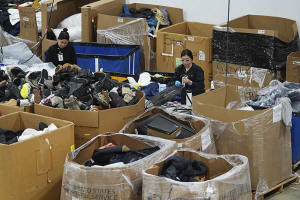Secondhand stores are poised to benefit if US tariffs drive up new
clothing costs
[April 21, 2025] By
ANNE D'INNOCENZIO
NEW YORK (AP) — Stores selling secondhand clothes, shoes and accessories
are poised to benefit from President Donald Trump'strade war even as
businesses the world over race to avert potential damage, according to
industry experts.
American styles carry international influence, but nearly all of the
clothing sold domestically is made elsewhere. The Yale University Budget
Lab last week estimated short-term consumer price increases of 65% for
clothes and 87% for leather goods, noting U.S. tariffs
"disproportionately affect” those goods.
Such price hikes may drive cost-conscious shoppers to online resale
sites, consignment boutiques and thrift stores in search of bargains or
a way to turn their wardrobes into cash. Used items cost less than their
new equivalents and only would be subject to tariffs if they come from
outside the country.
“I think resale is going to grow in a market that is declining,” said
Kristen Classi-Zummo, an apparel industry analyst at market research
firm Circana. “What I think is going to continue to win in this chaotic
environment are channels that bring value.”
The outlook for pre-owned fashion nevertheless comes with unknowns,
including whether the president's tariffs will stay long enough to pinch
consumers and change their behavior. It's also unclear whether
secondhand purveyors will increase their own prices, either to mirror
the overall market or in response to shopper demand.
A new audience courtesy of sticker shock
Jan Genovese, a retired fashion executive, sells her unwanted designer
clothes through customer-to-customer marketplaces like Mercari. If
tariffs cause retail prices to rise, she would consider high-end
secondhand sites.

“Until I see it and really have that sticker shock, I can’t say
exclusively that I’ll be pushed into another direction,” Genovese, 75,
said. “I think that the tariff part of it is that you definitely rethink
things. And maybe I will start looking at alternative venues.”
The secondhand clothing market already was flourishing before the
specter of tariffs bedeviled the U.S. fashion industry. Management
consulting firm McKinsey and Co. predicted after the COVID-19 pandemic
that global revenue from pre-owned fashion would grow 11 times faster
than retail apparel sales by this year as shoppers looked to save money
or spend it in a more environmentally conscious way.
While millennials and members of Generation Z were known as the primary
buyers of used clothing, data from market research firm Sensor Tower
shows the audience may be expanding.
The number of mobile app downloads for nine resale marketplaces the firm
tracks — eBay, OfferUp, Poshmark, Mercari, Craigslist, Depop, ThredUp,
TheRealReal and Vinted — increased by 3% between January and the end of
March, the first quarterly gain in three years, Sensor Tower said.
The firm estimates downloads of the apps for eBay, Depop, ThredUp and
The RealReal also surged compared to a year earlier for the week of
March 31, which was when Trump unveiled since-paused punitive tariffs on
dozens of countries.
Circana’s Classi-Zummo said that while customers used to seek out
collectible or unusual vintage pieces to supplement their wardrobes, she
has noticed more shoppers turning to secondhand sites to replace regular
fashion items.
"It's still a cheaper option” than buying new, even though retailers
offer discounts, she said.

A tariff-free gold mine lurking in closets and warehouses
Poshmark, a digital platform where users buy and sell pre-owned
clothing, has yet to see sales pick up under the tariff schedule Trump
unveiled but is prepared to capitalize on the moment, CEO Manish Chandra
said.
Companies operating e-commerce marketplaces upgrade their technology to
make it easier to find items. A visual search tool and other
improvements to the Poshmark experience will “pay long dividends in
terms of disruption that happens in the market” from the tariffs,
Chandra said.
[to top of second column] |

People work amid boxes of returned or overstocked clothing, shoes,
boots, coats, packs and other items in a warehouse where the goods
are cleaned or repaired before they are marketed on resale platforms
in Englewood, Colo., on Thursday, April 17, 2025. (AP Photo/David
Zalubowski)
 Archive, a San Francisco-based
technology company that builds and manages online and in-store
resale programs for brands including Dr. Martens, The North Face and
Lululemon, has noticed clothing labels expressing more urgency to
team up, CEO Emily Gittins said.
"Tapping into all of the inventory that is already sitting in the
U.S., either in people’s closets or in warehouses not being used,”
offers a revenue source while brands limit or suspend orders from
foreign manufacturers, she said.
“There’s a huge amount of uncertainty,” Gittins said. “Everyone
believes that this is going to be hugely damaging to consumer goods
brands that sell in the U.S. So resale is basically where everyone’s
head is going."
Stock analysts have predicted off-price retailers like TJ Maxx and
Burlington Stores will weather tariffs more easily than regular
apparel chains and department stores because they carry leftover
merchandise in the U.S.
Priced out of the previously owned market
Still, resale vendors aren't immune from tariff-induced upheavals,
said Rachel Kibbe, founder and CEO of Circular Services Group, a
firm that advises brands and retailers on reducing the fashion
industry's environmental impact.
U.S. sellers that import secondhand inventory from European Union
countries would have to pay a 20% duty if Trump moves forward with
instituting “reciprocal” tariffs on most trading partners and
eliminates an import tax exception for parcels worth less than $800,
Kibbe said.
A circular fashion coalition she leads is seeking a tariff exemption
for used and recycled goods that will be offered for resale, Kibbe
said. Trump already ended the duty-free provision for low-value
parcels from China, a move that may benefit sellers of secondhand
clothing by making low-priced Chinese fashions pricier, she said.

James Reinhart, co-founder and CEO of the online consignment
marketplace ThredUp, said the removal of the “de minimis” provision
and the 145% tariff Trump put on products made in China would
benefit businesses like his. He doubts creating resale channels
would make a big difference for individual brands.
“Brands will explore this and they may do more, but I don’t see them
massively changing their operations,” Reinhart said. “I think
they’re going to be figuring out how to survive. And I don’t think
resale helps you survive.”
Rebag, an online marketplace and retail chain that sells used
designer handbags priced from $500 to tens of thousands of dollars,
expects tariffs to help drive new customers and plans to open more
physical stores, CEO Charles Gorra said.
Gorra said the company would analyze prices for new luxury goods and
adjust what Rebag charges accordingly. The two historically rose in
tandem, but Rebag could not match Chanel's 10% price increase last
year because of lower resale demand, Gorra said.
“That has nothing to do with the tariffs,” he said. “Consumers are
feeling priced out.”
Norah Brotman, 22, a senior at the University of Minnesota, buys
most of her own clothes on eBay. She also thrifts fashions from the
1990s and early 2000s at Goodwill stores and resells them on Depop.
If tariffs upend the economics of fast fashion and discourage
mindless consumption, Brotman would count that as a plus.
“I would love if this would steer people in a different direction,”
she said.
All contents © copyright 2025 Associated Press. All rights reserved |